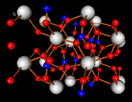About the chemical structure:
| Chemical name: | calcium carbonate (chalk) calcium carbonate + calcium hydroxide (bianco San Giovanni) |
| Formula: | CaCO3 (chalk) CaCO3 + Ca(OH)2 (bianco di San Giovanni) |
| 3D model: |
grey = carbon, red = oxygen, blue = calcium |
| Crystal system: | Trigonal - Hexagonal Scalenohedral (at Mineralogy Database) |
| Refractive index: | calcite: e =1.486, w =1.64 -1.66 |
Color:
| Color Index (C.I.) | PW 18 (chalk, bianco di San Giovanni) |
How can you identify Lime white?
Imaging:
UVF: no
Analytics:
It's identified by means of FTIR and Raman.
Raman spectra: University College London;
FTIR: IRUG
Usage and handling:
| Permanence: | Toxicity: |
|---|---|
| Lightfast: excellent Degradation processes: bianco di San Giovanni is incompatible with alkali-sensitive pigments such as Prussian blue. Lime white is considered the white pigment par excellence for fresco painting. It is used also in tempera and grounds while it is not advised in oil and encaustic painting techniques. |
non toxic. Lime white is not toxic, however, bianco di San Giovanni is alkaline and may irritate the skin and eyes. Care should be used in handling the dry powder pigment to avoid inhaling the dust. MSDS: Natural pigments (Bianco di san Giovanni) MSDS: Kremer (Chalk) |
Literature:
Artists’ Pigments. A Handbook of Their History and Characteristics, Vol. 2: A. Roy (Ed.) Oxford University Press 1993, p. 203-226


